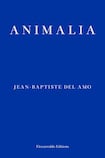
“Man hands on misery to man./It deepens like a coastal shelf.”, wrote Philip Larkin, unable to imagine a break in the line of sorrow we inherit from those who have suffered before us. For the benighted characters of Jean-Baptiste Del Amo’s powerful novel Animalia, that legacy seems as unlikely to change as the movement of the seasons in a novel which – like those of Larkin’s literary hero Thomas Hardy – is imbued with nature and the inevitability of death. But one of the many fascinating aspects of this novel is the way in which a sense of inevitability can loosen to allow for other possibilities and our perspective can be altered in unanticipated ways.
The novel consists of four chapters of about 100 pages each. The first two bring us from 1898 to 1917 on a farm in a remote region of France. While remaining there, we then take a leap forward to 1981 for the other two chapters. One character is present throughout the novel, Eléonore, who we first meet as a child, unusually quiet and always seeking the whisper of human warmth she receives from her father. Her mother, referred to as “the genetrix” – until a later change in status – is not someone in whom her daughter can ever hope to find comfort. Eléonore “quickly learns to emulate her in her tasks . . . At five years old, she holds herself stiff and staid as a farmer’s wife.” Her mother is pious and reconciled to the essential evil of humans, a judgment she can bolster with the many biblical passages she knows by heart.
Sensuous encounters
For Eléonore, the arrival of Marcel, a cousin who must carry out the duties her increasingly ill father can no longer undertake is a unique moment of optimism. Prior to this her only consolation has been her sensuous encounters with nature. But with Marcel – though he is as taciturn as everyone else in the novel – comes the possibility to imagine. However, the world of this farm, with its repressed inhabitants and its pitiless landscape, is not a location in which hope will ever take root.
When we move forward to new generations, it quickly becomes obvious that fresh shades of darkness have replaced those worn by time. If anything, the callousness has increased. There is now a level of cruelty, largely absent before, which has intensified with the enlarged farm, now dedicated to rearing pigs. Two brothers, Serge and Jérôme, and their father, Henri, attend to matters with violence and hostility, as much towards each other as towards the animals. For those who live with these men, dysfunction and detachment become options of escape. These manifest themselves in a variety of ways, most interestingly in the case of Jérôme, the son of Serge and his wife Catherine, a manic depressive, largely confined to her bed.
Throughout the novel, characters have found release in close observations of nature and this is especially the case with Jérôme who wanders freely, pushing past the constraining boundaries of the farm. In the midst of remarkable writing which is attentive to every movement, every sound and every silence – in a beautifully detailed translation by Frank Wynne – we can join Jérôme as he lies in a graveyard and “allows the minutes and the hours to wash over him, sometimes half-opening his eyes to watch the confused ballet of the swallows, the treetops of the cypresses swaying gently in the breeze, the cones falling, bouncing and skittering over the steps”.
Destructive legacy
Jérôme and his sister, Julie-Marie, represent a break with the destructive legacy. Although it is difficult to know how his deep immersion in nature and her promiscuity will play out in their lives, they symbolise a rupture in the previous pattern. Symbolism is important throughout the novel and is always made to work. So, Eléonore’s moment of menarche, in extraordinary circumstances, is both striking and affecting.
Something in the life of all those on the farm goes uncontrollably awry. This is well represented by the fate of the pigs and especially by the near-mythical one known as “The Beast”, a grotesquely oversized boar of whom Henri is immensely proud. Initially, it seems, it is a symbol of male ferocity. Our early assumptions about this creature have to undergo revision as we understand he too wants the freedom and succour of nature: “ Images come back to him, surfacing from atavistic memory: plains and forage fields, wallows built among the ferns, deep in primeval forests, wild rivers from whose swift currents he drinks”. Which of us animals would not long for this?












